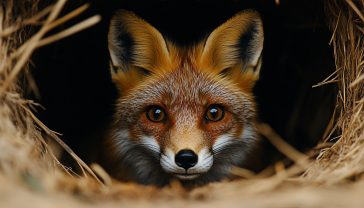How Long Do Foxes Live? Lifespan in the Wild and Captivity.
Foxes are known for their cunning nature, but how long do they actually live? Discover the lifespan of foxes and what influences their survival in the wild and captivity.

This post may contain affiliate links. If you make a purchase through these links, we may earn a commission at no additional cost to you.
Have you ever wondered how long foxes live? These cunning, adaptable creatures roam forests, deserts, and tundras, but their lifespans vary dramatically depending on where they live and the challenges they face. From the resourceful red fox to the desert-dwelling fennec, each species tells a fascinating story of survival. But what determines a fox’s longevity? Let’s explore the factors influencing the lifespan of foxes in the wild and in captivity—and discover how these clever animals navigate life’s hurdles.
Fox Lifespan in the Wild: A Game of Survival
In the wild, life isn’t easy for a fox. Predators, harsh climates, diseases, and human threats all contribute to a shorter lifespan compared to their captive counterparts. Despite their intelligence and agility, most foxes face a tough road from birth to adulthood.
Red Foxes (Vulpes vulpes): The World’s Most Widespread Fox
The adaptable red fox lives 2 to 5 years in the wild. Although they can live over 10 years, few reach this age due to threats like predation, disease, and human interference. Think of red foxes as nature’s great opportunists—clever enough to survive in urban environments but still vulnerable to dangers such as traffic and habitat loss.
Arctic Foxes (Vulpes lagopus): Survivors of the Frozen North
Arctic foxes, enduring 3 to 6 years in the wild, face brutal winters, food scarcity, and competition from larger predators like wolves and polar bears. Although they are built for cold survival, the constant search for food and shelter shortens their lifespan.
Fennec Foxes (Vulpes zerda): Masters of the Desert Night
Small but mighty, Fennec foxes live 6 to 10 years in the wild. Their nocturnal lifestyle helps them avoid extreme daytime temperatures and predators. This strategy, coupled with a diet of insects, plants, and small vertebrates, helps them outlive many other fox species.
Grey Foxes (Urocyon cinereoargenteus): The Climbing Canines
With an average lifespan of 2 to 4 years, grey foxes are unique climbers, using trees to escape predators. However, despite this advantage, they still face significant threats from diseases, predators, and human activities that limit their longevity.
Foxes in Captivity: A Longer, Safer Life
Remove predators, provide regular meals, and add veterinary care—and the result? A fox’s lifespan significantly increases in captivity. Without the daily fight for survival, foxes can live well into their teens.
Red Foxes: In captivity, they can live 10 to 14 years, with some reaching 15 years. Access to medical care and consistent food sources drastically reduce risks of disease and starvation.
Arctic Foxes: Free from the harsh Arctic environment, these foxes live 10 to 12 years in captivity. The absence of extreme temperatures and predation gives them a notable longevity boost.
Fennec Foxes: The adaptable Fennec fox can live up to 14 years in captivity. Their small size and manageable care requirements make them popular in zoos and among exotic pet enthusiasts.
Grey Foxes: Given proper care, grey foxes can live up to 10 years in captivity. Though not as common in domestic settings, those in wildlife sanctuaries benefit from safety and stability.
What Affects How Long Foxes Live?
Not all foxes live equally long lives. Several factors influence their lifespan, both in the wild and in captivity:
1. Predation: Living Life on the Run
Larger predators like wolves, coyotes, and birds of prey pose constant threats. Even the most agile foxes can fall victim, shortening their lifespan considerably. For some species, such as grey foxes, the ability to climb trees offers an edge—but not a guarantee of survival.
2. Disease: Nature’s Silent Threat
Rabies, mange, and canine distemper are major killers. Mange, caused by parasitic mites, leads to fur loss and skin infections, leaving foxes vulnerable to the elements and starvation. Without treatment—readily available in captivity but not in the wild—such diseases are often fatal.
3. Food Availability: Feast or Famine
Starvation is a real threat. In the wild, food shortages caused by harsh winters or desert droughts can mean the difference between life and death. Foxes in areas rich in prey and vegetation tend to live longer, while those in harsher environments face constant nutritional stress.
4. Human Impact: Friend or Foe?
Urban foxes sometimes benefit from human leftovers, yet face dangers like traffic accidents, hunting, and poisoning. Additionally, habitat destruction forces foxes into unfamiliar territories, increasing risks and reducing lifespans.
5. Climate and Environment: Adapt or Perish
Whether enduring Arctic cold or desert heat, foxes adapt to survive—but these extreme conditions come at a cost. Species like the Arctic fox have short windows to raise young before winter returns, limiting the time they have to thrive.
The Fox Life Cycle: From Helpless Kit to Independent Hunter
Foxes don’t just survive—they follow a remarkable life cycle packed with rapid growth and learning.
Birth and Early Life: The Vulnerable Beginning
After a 50-day gestation, fox kits are born blind and helpless. Litter sizes range from 4 to 6 kits, depending on the species. The vixen (mother) provides warmth and nourishment, while the dog (male) hunts to feed the family.
Juvenile Stage: Learning the Ropes
By 2 weeks, kits open their eyes, and by 3 to 4 months, they join hunting trips with their parents. This period is critical for learning hunting techniques and predator avoidance—skills essential for survival.
Adulthood: Independence and Territory
At 10 months, foxes become independent, establishing their own territories. Here, survival becomes a solo mission, with each day bringing new challenges.
Reproduction: Continuing the Cycle
By the age of 1 year, most foxes reach sexual maturity. The cycle repeats, with winter breeding leading to new litters each spring.
Foxes in Focus: How Long Do They Really Live?
So, how long do foxes live? The answer isn’t one-size-fits-all:
- In the Wild: Most live 2 to 5 years, though some species, like the Fennec fox, can push this to 10 years under ideal conditions.
- In Captivity: Free from predators, starvation, and disease, foxes can live up to 14 years or more.
Fascinating Insights: Did You Know?
- The oldest known red fox in captivity lived to 21 years!
- Fennec foxes, despite their small size, can outlive larger foxes thanks to their adaptable diets and nocturnal habits.
- Urban foxes in some UK cities have been observed living longer than their rural counterparts due to steady food supplies—though traffic remains a major threat.
Conclusion: The Remarkable Journey of Foxes
From the icy Arctic tundras to scorching desert sands, foxes are survivors. While most live just a few years in the wild, their story doesn’t end there. In captivity, where food, shelter, and medical care are guaranteed, foxes can thrive for over a decade, sometimes reaching 14 years or more.
Foxes remind us that survival is a delicate balance between adaptability, environment, and resilience. So next time you spot a fox darting through the countryside or hear a distant call at night, remember—you’re witnessing one chapter in a life defined by cunning, courage, and the will to survive.






